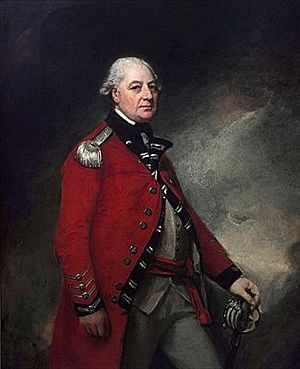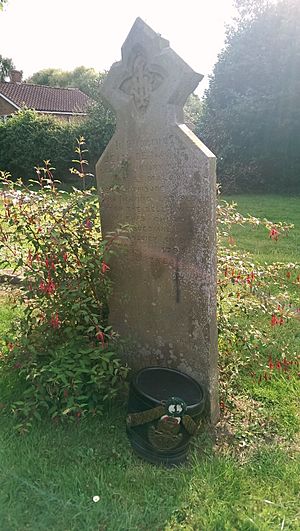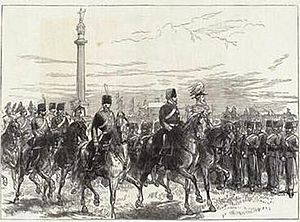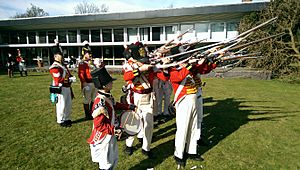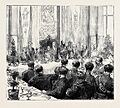Norfolk Militia facts for kids
Quick facts for kids Norfolk Militia |
|
|---|---|
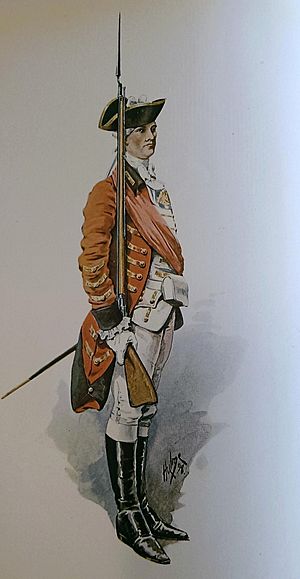
Officer of the Norfolk Militia, 1759
|
|
| Active | 1757–1881 |
| Country | |
| Branch | |
| Type | Infantry |
| Garrison/HQ | Gorleston Barracks, Great Yarmouth |
| Facings | Black |
| Commanders | |
| Current commander |
n/a |
| Notable commanders |
George Walpole, 3rd Earl of Orford George Townshend, 1st Marquess Townshend Edward VII, as Prince of Wales |
The Norfolk Militia was a group of part-time soldiers from Norfolk, England. It was officially formed in 1757. Before this, local defense groups were less organized.
The new rules meant that men were chosen by a lottery system. They served for longer periods than before. They also received proper uniforms and better weapons. The militia would gather for training sessions from time to time.
In 1758, the Earl of Orford helped set up the militia in Norfolk. They decided that 960 men would serve. The city of Norwich provided 151 of these men. The Norfolk Militia was split into two main groups:
- The 1st Battalion Western Regiment of the Norfolk Militia (West Norfolk Militia)
- The 2nd Battalion Eastern Regiment of the Norfolk Militia (East Norfolk Militia)
For a short time between 1797 and 1798, there was also a 3rd Battalion. However, it was not reformed later on.
The East Norfolk Militia was one of the first groups formed under the new 1757 law. It was also known for being the first to offer to "march wherever they might be most serviceable to the public defence." King George II wanted to show special favor to this group. He decided they should be called "Militia Royal."
Contents
History of the Norfolk Militia
Early Days and Training
On June 4, 1759, the Eastern Battalion had a review. This took place near Norwich. Newspapers reported that the men behaved very well. They said the unit could be ready to march in just four days.
The unit had a specific number of officers and soldiers. It included a Colonel, a Lieutenant Colonel, a Major, and many Captains and Lieutenants. There were also Sergeants, drummers, and 466 regular soldiers.
Soon after, on July 4, 1759, both battalions began a long march. They traveled from Norwich to Portsmouth barracks. They marched through several towns, including Ipswich and Colchester. They arrived in Portsmouth on July 24. During their journey, King George II reviewed them at Kensington Palace. Even though it was hot, the soldiers were in good spirits. By August, they were guarding prisoners of war and practicing their military skills.
The Militia moved around England quite a bit. On July 5, 1760, they were in Cirencester. But in July, they moved back to Norfolk to guard prisoners. On May 28, 1761, King George gave the two Norfolk Militia battalions special "Warrants for Colours." This meant they received their official flags.
In 1759, a training guide was published for the Norfolk Militia. This book, called "A Plan of Discipline," became very important. It was even used as a drill manual during the American Revolution.
Service in Ireland
In September 1798, many officers and soldiers volunteered for duty in Ireland. This was during the Irish Rebellion of 1798.
Later, in 1815 and 1816, eight hundred men from the West Norfolk Militia served in Ireland. An author named George Borrow wrote about this in his book Lavengro. Borrow's father had been a Captain in the unit.
The Dereham Incident
In 1799, the East Norfolk Militia was moving French prisoners of war. They were going from Great Yarmouth to Norman Cross. One night, the prisoners stayed in the bell tower of Dereham church.
A 28-year-old French lieutenant named Jean De Narde tried to escape. He got out of the tower but couldn't leave the churchyard. Sentries were guarding the area. De Narde hid in a tree, but a sergeant found him. When De Narde did not surrender, the sergeant shot him.
The local people of Dereham felt sad about this event. They raised money to build a monument for Jean De Narde. Years later, in 2016, a memorial service was held for him at Dereham church. A short film about the shooting was released in 2017.
Facing Invasion in 1805
In 1805, Britain was at war with France. The French leader, Napoleon, planned to invade England. He gathered his army at Boulogne. To protect Britain, the Norfolk Militia was ordered to the Southern District. This area covered parts of Kent, Sussex, and Essex.
The East and West Norfolk Militia regiments were stationed in Winchelsea. The West Norfolk Militia had 712 men. The East Norfolk Militia had 698 men. They were ready to defend the country.
Prisoner of War Duties
A special camp for prisoners of war was built at Norman Cross. This was the first camp of its kind. The Norfolk Militia played a big role in moving prisoners there. They also helped run the camp.
Lieutenant Thomas Borrow of the West Norfolk Militia lived at Norman Cross from 1811 to 1813. His son, George Borrow, who later became a famous author, spent two years of his childhood there.
Later Years and Training
The Militia was sent home in 1814. They were not called up again until 1820.
In 1853, 612 men of the West Norfolk Militia gathered in Norwich. The East Norfolk Militia, with 571 men, met in Great Yarmouth. People were surprised by how well-behaved and respectable the soldiers looked.
The East Norfolk Militia received new flags on May 16, 1854. This was a big public event in Great Yarmouth. About 10,000 people attended, including important local leaders. The day ended with a fancy ball.
New barracks for the Militia were planned in Great Yarmouth in 1853. By 1855, the old barracks were turned into a hospital. The government planned to use the arsenal at Yarmouth to create Gorleston Barracks. This would house the East Norfolk Militia.
In 1856, the East Norfolk Militia traveled by train to a camp in Colchester. They were met by a band. Their strength at this time was 1 Major, 13 officers, 3 sergeants, and 415 men.
On April 23, Prince Albert reviewed the units at Colchester, including the East Norfolk Militia. Soon after, the East Norfolk Militia returned to Great Yarmouth.
On May 20, 1861, the East Norfolk Militia was involved in a serious fight in Yarmouth. They clashed with men from the Royal Artillery. The fight involved belts and stones. Officers from both sides had to step in to stop it. Guards were placed on the bridge to keep the two groups apart.
Norfolk Artillery Militia
In 1853, the Norfolk Militia Artillery was formed. Men from both the West and East Norfolk Militia joined it. Their strength grew from 200 to 400 men.
Around 1860, the Norfolk Artillery Militia got barracks in Norwich. These barracks included a parade ground and stables. They were used until the late 1920s.
The Prince of Wales became the Honorary Colonel of the Artillery Militia in 1871. In 1875, the regiment was renamed The Prince of Wales's Own Norfolk Artillery. They often used the Great Yarmouth Assembly Rooms for their officers' dinners. They practiced artillery on South Denes.
In 1882, the unit's name changed again. It became the Prince of Wales's Own 2nd Brigade, Eastern Division, Royal Artillery.
During the Second Anglo-Boer War in 1901, some officers and soldiers from this unit went to Cape Town. They served on armored trains and did other duties like intelligence work.
Thorpe Rail Disaster, 1874
Two soldiers from the West Norfolk Militia died in the Thorpe rail accident in 1874. Sergeant Major Frederick Cassell and Sergeant Robert Ward were returning from a fishing trip. Their bodies were found, and they were buried with full military honors.
Uniform of the Norfolk Militia
The East Norfolk Militia wore scarlet uniforms with black details. An early drawing from 1759 shows a soldier in a simple uniform. He wore a hat, jacket, breeches (short trousers), and shoes. He had a cross belt and a waist belt with a bayonet.
Long boots were stopped in 1814, except for officers on horseback. In 1820, the decorations on uniforms changed from gold to silver. However, officers could keep their old uniforms if they weren't on active duty. By 1831, all uniforms had to follow the latest rules. They included black velvet and silver shoulder decorations.
Gold lace was brought back to the East Norfolk Militia in 1882. At the same time, the badge of the 4th Battalion Norfolk Regiment changed. It went from a castle and lion to the figure of Britannia.
Notable Members
- George Stracey Smyth: A Captain in the East Norfolk Militia. He later became the Lieutenant-Governor of New Brunswick.
- Sir George Berney Brograve, 2nd Baronet: A Lieutenant Colonel in the Militia. He was also the High Sheriff of Norfolk in 1802.
- Major John Money: One of the first English people to fly in a hot air balloon in 1785. He also suggested using balloons for military purposes in 1803.
- Edwin Alfred Hervey Alderson: A Lieutenant in the Artillery Militia from 1876-78. He later became a Lieutenant General. He commanded the Canadian Expeditionary Force in World War I.
What Happened Next: Successor Units
In 1881, the British Army was reorganized. The West Norfolk Militia became the 3rd Battalion of the Norfolk Regiment. The East Norfolk Militia became the 4th Battalion.
Later, the Norfolk Regiment joined with the Suffolk Regiment. They formed the 1st East Anglian Regiment. In 1964, this regiment became part of the Royal Anglian Regiment.
East Norfolk Militia (Re-enactment Group)
The East Norfolk Militia is a group that re-enacts the Napoleonic era. They formed in 2000 to celebrate a special event. This was the 200th anniversary of Horatio Nelson, 1st Viscount Nelson receiving an honor in Great Yarmouth.
In 2005, they took part in events for the 200th anniversary of the Battle of Trafalgar. They perform ceremonial duties and guard events around East Anglia. They also participate in "living history" events. In 2015, they even took part in the re-enactment of the Battle of Waterloo.
Images for kids


